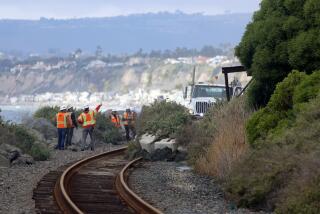Union Pacific Still Struggling With Congestion
- Share via
Congestion woes continue to plague Union Pacific Corp. several months after it vowed to beef up service to ease massive logjams, particularly in Southern California.
Union Pacific has added thousands of employees and hundreds of locomotives nationwide. But the country’s largest railroad is struggling to keep up with surging freight volumes, according to customers and analysts.
“It’s terrible. We’re still seeing eight-to-10-day delays,” said Brian Horowitz, owner of On the Edge Marketing, a Lake Forest marketer of all-terrain vehicles and other products that ships via Union Pacific.
About one-quarter of Union Pacific’s freight either originates in Southern California or ends up here. Among what it transports are imports from Asia that flow through the Los Angeles and Long Beach ports, which have managed to unsnarl their waterborne traffic tangle.
For the railroad, “congestion and service issues still abound,” analyst Donald Broughton of A.G. Edwards & Sons Inc. said in a report last week.
It’s taking 24 to 36 hours longer than normal for Toyota Motor Sales U.S.A. in Torrance to get repair parts from Japan through the Los Angeles port and out to its main distribution warehouse in Ontario, said spokesman Xavier Dominicis.
That delays aren’t as bad as the four-day holdups Toyota experienced in October, when a crush of holiday shipping brought near-record port congestion, but it’s still “not a good situation,” he said.
Another Union Pacific customer, Imperial County feed supplier Randy Armstrong, said he was forced to find alternative sources of corn feed last week. “I had to truck some down from Los Angeles” at an added cost of $1,300, said Armstrong, grain division manager at Agri-Feed Industries.
Union Pacific spokesman John Bromley said that although the railroad’s operations were improving, “we’re not saying it’s fixed. The service is not to the level we want.”
The Omaha-based railroad, which operates 33,000 miles of track from the Midwest to the West Coast, began suffering major bottlenecks last spring. It was the second time in six years that it had experienced severe congestion problems.
Union Pacific blamed the problems mainly on two events that caught it off guard: a surge in the U.S. economy and crew shortages brought on by changes in railroad labor laws that sparked a rash of retirements.
Deliveries of a wide variety of products, including lumber and consumer electronics, were delayed as Union Pacific’s trains slowed to below-average speeds or spent too much time sitting idle. Some shippers scrambled to shift their loads to the other major railroad serving California, Burlington Northern Santa Fe Corp.
Union Pacific responded by aggressively hiring workers and buying new locomotives. Although employee training takes time, Union Pacific still should be performing better by now, Broughton wrote in his report.
Another analyst, Thomas Wadewitz of Bear, Stearns & Co., cited “a trend of deterioration” in the railroad’s service in downgrading his rating on Union Pacific’s stock Friday.
The stock closed the week at $64.80 a share, down 80 cents, on the New York Stock Exchange.
Broughton also complained that Union Pacific “isn’t even willing to suggest that it has a plan or has a time frame in which we should expect to see service begin to improve.”
Bromley, the Union Pacific spokesman, said the carrier did have a plan. The analysts “are getting impatient to see results,” Bromley said. “But it’s going to take time and we’ve never promised anyone any deadline.”
In the first nine months of 2004, Union Pacific’s profit tumbled 49% from a year earlier, to $525 million from $1.03 billion, despite a 5% gain in revenue to $9 billion from $8.6 billion.
The company’s problems echo congestion snafus that dogged Union Pacific in 1997-98, and they indicate the company is straining to keep up with a U.S. economy that is dependent on the railroad to keep goods flowing, said John Husing, an independent economist in Redlands.
“They’ve never really gotten in front of the curve,” he said. “They didn’t understand the volume that would come at them.”
And pressure on Union Pacific to improve its West Coast performance is expected only to heighten.
Ports in Southern California and elsewhere on the Pacific Coast should brace for a swell of cargo from China, after the recent elimination of restrictions on that country’s apparel and textile exports by the World Trade Organization, shipping experts have said.
Times staff writers John O’Dell and Roger Vincent contributed to this report.
More to Read
Inside the business of entertainment
The Wide Shot brings you news, analysis and insights on everything from streaming wars to production — and what it all means for the future.
You may occasionally receive promotional content from the Los Angeles Times.











